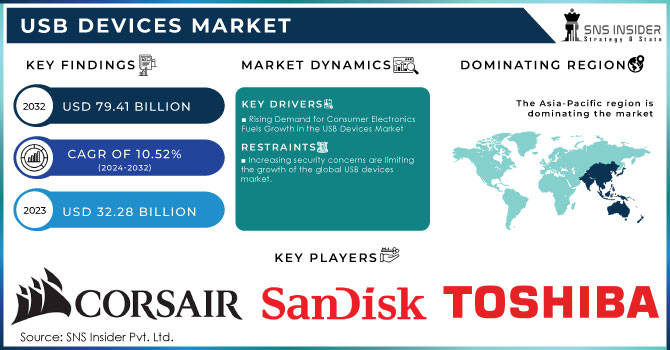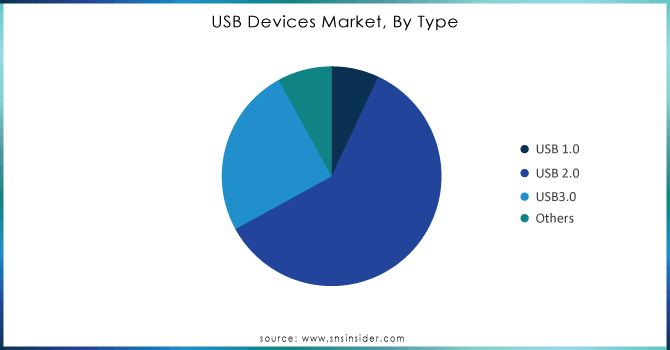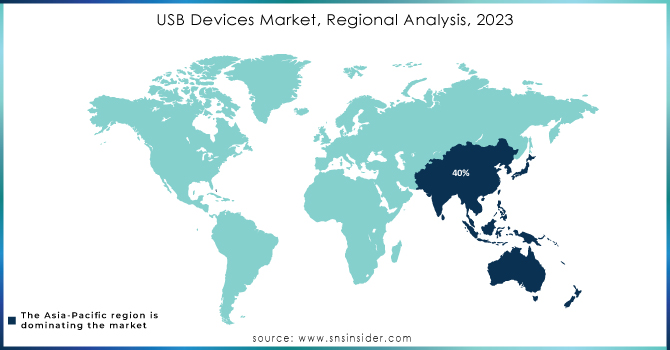USB Devices Market Size and Overview

Get more information on USB Devices Market - Request Sample Report
The USB Devices Market Size was valued at USD 32.28 billion in 2023 and is expected to reach USD 79.41 billion by 2032 and grow at a CAGR of 10.52 % over the forecast period 2024-2032.
The USB devices market has seen consistent growth due to rising needs for effective data transfer and power supply solutions in various sectors. The USB technology has advanced greatly since it was first introduced, moving through different versions like USB 1.0 all the way to the most recent USB4. This development has led to increased data transfer speeds, enhanced power delivery capabilities, and greater compatibility among devices, encouraging widespread usage. The market consists of a variety of USB-compatible devices like flash drives, external hard drives, keyboards, mice, printers, cameras, and smartphones. The market has been strengthened by the growing dependence on external storage options like USB flash drives and external SSDs, which provide quick, trustworthy data storage and easy portability. The rise of USB Type-C has increased growth by allowing faster data transfer speeds (up to 40 Gbps with USB4) and enhanced power delivery, making it a top choice for laptops, smartphones, and other high-power devices. The increase in remote work and digital content creation has driven the need for USB hubs and docking stations, enabling users to effortlessly connect multiple peripherals to their computers. The USB market is experiencing advantages due to the expansion of the gaming sector, with USB-connected devices like gaming mice, keyboards, and headsets now being necessary.
The growing demand for USB analysis and experimentation tools is contributing to the broader expansion of the USB devices market, driven by advancements in FPGA-powered solutions. As technology continues to evolve, there is an increasing need for cost-effective tools that allow both professionals and enthusiasts to explore, capture, and manipulate USB data. Recently, a new FPGA-based hardware platform has emerged, offering a more affordable alternative to commercial USB analyzers. Priced between USD149.99 and USD 210, this tool is designed for USB packet capture, analysis, and even devices creation. It supports low, full, and high-speed USB operations, making it a versatile option for both experienced users and those new to USB technology. The platform is further enhanced by open-source software libraries that allow users to quickly develop and test custom USB devices without needing in-depth knowledge of digital hardware design or FPGA architecture. Such tools are essential for research and development, as well as security testing, given the growing complexity and ubiquity of USB technology in modern electronics. With the rising prevalence of USB devices in industries like consumer electronics, automotive, and IoT, the demand for such innovative tools is expected to grow. Moreover, the USB devices market is being fueled by the increasing adoption of USB Type-C and USB4, which offer faster data transfer speeds and greater power delivery capabilities. This aligns with the rise of remote work, digital content creation, and the proliferation of IoT devices, all of which rely on USB interfaces for data transfer and power. As a result, the USB devices market is to expand steadily, driven by the growing need for more efficient and flexible USB solutions, including advanced analysis and development platforms.
USB Devices Market Dynamics
Drivers
-
Rising Demand for Consumer Electronics Fuels Growth in the USB Devices Market
The surge in consumer electronics usage is playing a pivotal role in driving the expansion of the USB devices market, with devices like smartphones, tablets, and digital cameras becoming essential parts of everyday life. USB devices, commonly known as USB sticks or keys, provide a seamless interface for data storage and transfer across a wide array of devices. From webcams and memory card readers to digital audio players, USB technology offers connectivity solutions that are indispensable in modern consumer electronics. The global rise in demand for these electronics is particularly evident as more people across all age groups adopt mobile devices, smart TVs, and laptops, creating a fertile ground for the USB devices market to thrive. As consumer electronics technologies rapidly evolve, the need for efficient data transfer solutions, such as USB devices, becomes increasingly critical. According to a Pew Research Center survey conducted from May to September 2023, 95% of U.S. adults now use the internet, 90% own a smartphone, and 80% subscribe to high-speed internet at home. This digital penetration underscores the critical role of USB devices as a primary method of exchanging data between end devices like laptops, PCs, and digital cameras. Furthermore, the rapid technological advancements in consumer electronics—ranging from smart home devices to wearable tech—are accelerating the demand for enhanced USB interfaces, such as USB Type-C and USB4, which offer faster data transfer speeds and improved power delivery capabilities. With major manufacturers continuously innovating and producing new USB products to meet this rising demand, the market is expected to see sustained growth. As governments worldwide promote digital connectivity, including initiatives like the U.S. Federal Communications Commission's (FCC) broadband expansion efforts, the USB devices market is poised for further expansion in tandem with the flourishing consumer electronics sector
Restraints
-
Increasing security concerns are limiting the growth of the global USB devices market.
As the USB devices Market grows, increasing security concerns pose a major obstacle to its expansion. Despite being appreciated for their mobility, cost-effectiveness, and ease of data transfer, USB devices are attractive to cyber attackers due to these very characteristics. Malware infections pose a high risk because attackers can exploit vulnerabilities with malicious USB drives that activate upon connection to a computer, potentially compromising sensitive data. According to a report from the Cybersecurity and Infrastructure Security Agency (CISA), malware can quickly spread via USB devices, resulting in extensive data breaches and critical information loss. Additionally, attackers can utilize USB devices to extract data from computers, presenting a significant security threat to individuals and organizations alike. The concerns are further heightened by the risks of misplacing or losing USB drives, which can inadvertently lead to the exposure of confidential information. Losing a USB devicescan result in decreased productivity, wasted time, and possible fines for data breaches, particularly in industries governed by stringent data protection laws, such as healthcare and finance. This increasing recognition of security risks is prompting consumers and organizations to reassess their reliance on USB devices, potentially impeding market growth in the future. With the rising emphasis on cybersecurity, companies may gravitate toward alternative solutions such as cloud storage or encrypted devices, which are likely to continue affecting the market for traditional USB devices.
USB Devices Market Segment Analysis
By Type
In the USB devices market, USB 2.0 captured a significant 60% revenue share in 2023, cementing its status as the dominant technology for data transfer and connectivity. This widespread adoption can be attributed to USB 2.0's robust performance, compatibility with a vast range of devices, and cost-effectiveness, making it ideal for consumer electronics, peripherals, and automotive Product Types. Many manufacturers continue to leverage USB 2.0 technology in products due to its established reliability and support across various platforms, ensuring seamless integration with older and newer devices alike. Recent product launches highlight this trend. For instance, several tech companies have introduced advanced USB 2.0 flash drives featuring enhanced security protocols and higher storage capacities to meet growing consumer demands. Additionally, manufacturers are developing USB 2.0 hubs and adapters that expand connectivity options for laptops and desktops, facilitating the connection of multiple peripherals simultaneously. Companies like SanDisk and Kingston have launched USB 2.0 drives that incorporate encryption features, catering to both personal and professional use. This focus on innovation within the USB 2.0 segment underscores its continued relevance and importance in the broader USB devices market, despite the emergence of newer standards like USB 3.0 and USB-C.

Get Customized Report as per your Business Requirement - Request For Customized Report
By Application
In 2023, Consumer Electronics dominated the USB devices market, accounting for a substantial 39% revenue share, underscoring the critical role that USB technology plays in modern electronic devices. This category encompasses a wide range of products, including smartphones, laptops, tablets, and gaming consoles, all of which rely heavily on USB interfaces for charging and data transfer. Major companies have responded to this demand with innovative product launches; for instance, Apple introduced its latest line of iPhones equipped with advanced USB-C ports, enhancing charging speeds and compatibility with various accessories. Similarly, Samsung unveiled its new Galaxy series smartphones, emphasizing USB connectivity for faster data transfers and synchronizing. Additionally, gaming companies like Sony and Microsoft have integrated USB ports in their consoles, allowing users to connect multiple peripherals like controllers and VR headsets. The ongoing evolution of consumer electronics and the increasing complexity of devices are driving the demand for efficient USB solutions, prompting manufacturers to develop high-quality USB connectors and accessories. As consumer expectations for connectivity and performance rise, the consumer electronics sector is expected to continue its leadership in the USB devices market, fostering innovation and integration across multiple platforms.
USB Devices Market Regional Outlook
In 2023, the Asia-Pacific region captured the largest revenue share in the USB devices market, accounting for 40% of the total market, driven by robust consumer electronics demand, rapid technological advancements, and a growing middle class. Countries like China, Japan, South Korea, and India are at the forefront of this growth, with their substantial investments in research and development fostering innovation in USB technologies.China, as a global manufacturing hub, continues to lead the charge in USB devices production. Notably, companies such as Huawei and Xiaomi have introduced devices equipped with advanced USB-C technology, promoting faster data transfer and charging capabilities. Huawei's latest smartphones integrate USB-C connectors, enhancing compatibility with a wide range of accessories.In Japan, tech giants like Sony and Panasonic are also developing high-performance USB devices. For instance, Sony launched a new line of high-speed USB flash drives aimed at creative professionals requiring fast and reliable data transfer for large files, such as videos and high-resolution images.South Korea's Samsung is significantly impacting the market, launching innovative USB-C cables and connectors designed for its Galaxy series smartphones and tablets, promoting seamless connectivity across devices. Furthermore, the rise of e-commerce platforms in countries like India is fueling the demand for USB devices, with local manufacturers like Zebronics introducing cost-effective USB peripherals that cater to budget-conscious consumers.As these countries invest in enhancing their technological infrastructure and support innovation, the Asia-Pacific region is set to maintain its dominance in the USB devices market, driving global trends and fostering an environment for new product developments.
In 2023, North America emerged as the second fastest-growing region in the USB devices market, fueled by advancements in technology, increasing demand for consumer electronics, and a focus on innovation. The United States and Canada lead the charge, with major companies like Apple, Microsoft, and SanDisk launching new USB products tailored for both consumer and enterprise Product Types. Apple introduced updated USB-C accessories for its latest MacBook lineup, enhancing data transfer speeds and compatibility with a wider range of devices, while Microsoft launched a series of USB hubs aimed at improving connectivity for remote work setups, acknowledging the growing trend of hybrid working environments. SanDisk, a leader in flash storage solutions, has expanded its portfolio of USB flash drives, introducing models with higher capacities and faster read/write speeds to meet the demands of content creators and professionals. Furthermore, as businesses in North America increasingly adopt cloud computing solutions, the reliance on USB devices for data transfer remains significant, particularly in sectors such as education and healthcare. This combination of robust consumer demand and innovative product launches positions North America as a key player in the USB devices market, poised for continued growth in the coming years.

Key Players
The key players in the USB devices market provide product and offering:
-
Corsair Memory (Corsair Flash Voyager GTX, Corsair Survivor Stealth)
-
Sandisk Corporation (SanDisk Ultra Flair USB 3.0 Flash Drive, SanDisk Extreme Pro USB 3.2 Solid State Flash Drive)
-
Toshiba Corporation (Toshiba TransMemory USB Flash Drive, Toshiba Canvio Basics Portable Hard Drive)
-
Micron Consumer Products Group (Micron 5100 Series SSD, Micron 1100 Series SSD)
-
Transcend Information (Transcend JetFlash 790, Transcend StoreJet 25M3)
-
Adata Technology (Adata UV350 USB Flash Drive, Adata DashDrive Elite HE720)
-
Kingston Technology Corporation (Kingston DataTraveler 100 G3, Kingston IronKey D300)
-
Samsung Electronics (Samsung Bar Plus USB 3.1 Flash Drive, Samsung Portable SSD T7)
-
Verbatim Americas (Verbatim Store 'n' Go USB Flash Drive, Verbatim V3 USB 3.0 Flash Drive)
-
Intel Corporation (Intel Optane Memory H10 with Solid State Storage, Intel USB 3.0 Flash Drive)
-
Teclast Electronics Co. Ltd. (Teclast USB Flash Drive, Teclast 256GB USB 3.0 Drive)
-
Netac Technology Co Ltd. (Netac N900S USB Flash Drive, Netac USB 3.0 Flash Drive)
-
Zebronics (Zebronics ZEB-Rush USB Flash Drive, Zebronics ZEB-FS100 USB Flash Drive)
-
Imation Corporation (Imation Flash Drive, Imation Secure USB Drive)
-
Others
Recent Development
-
August 6, 2024, Samsung Electronics America has introduced new 512GB capacities for its BAR Plus and FIT Plus USB 3.2 Gen1 Flash Drives. These latest drives maintain the sleek designs while offering ample storage for your favorite music, irreplaceable photos and videos, as well as essential work or school documents, ensuring quick data backup and wide devices compatibility.
-
In June 2024, Legrand | AV's C2G brand introduced a significant new product to their range of Superbooster USB extenders. C2G is introducing seven new models that are compatible with USB devices like high-bandwidth PTZ cameras, solid-state drives, interactive whiteboard printers, and touchscreen displays.
-
In June 2024, EPC, a leading worldwide innovator in enhancement-mode GaN power FETs and integrated circuits, unveiled the EPC2057, a 50 V, 8.5 mΩ model. This GaN FET is designed specifically to manage the evolving requirements of high-power USB-C devices used in eMobility, consumer electronics, and in-car charging.
| Report Attributes | Details |
|---|---|
| Market Size in 2023 | USD 32.28 Billion |
| Market Size by 2032 | USD 79.41 Billion |
| CAGR | CAGR of 10.52% From 2024 to 2032 |
| Base Year | 2023 |
| Forecast Period | 2024-2032 |
| Historical Data | 2020-2022 |
| Report Scope & Coverage | Market Size, Segments Analysis, Competitive Landscape, Regional Analysis, DROC & SWOT Analysis, Forecast Outlook |
| Key Segments | • By Type (USB 1.0, USB 2.0, USB3.0, Others) • By Product (Webcam, Memory Card Readers, Computer Peripherals, USB Flash Drives, Digital Audio Players, Scanners & Printers, Others) • By Connector Type (Type A, Type B, Type C, Lightning Connector) • By Application (Consumer Electronics, Automotive, It & Telecommunication, Healthcare & Medical Devices, Others) |
| Regional Analysis/Coverage | North America (US, Canada, Mexico), Europe (Eastern Europe [Poland, Romania, Hungary, Turkey, Rest of Eastern Europe] Western Europe] Germany, France, UK, Italy, Spain, Netherlands, Switzerland, Austria, Rest of Western Europe]), Asia-Pacific (China, India, Japan, South Korea, Vietnam, Singapore, Australia, Rest of Asia-Pacific), Middle East & Africa (Middle East [UAE, Egypt, Saudi Arabia, Qatar, Rest of Middle East], Africa [Nigeria, South Africa, Rest of Africa], Latin America (Brazil, Argentina, Colombia, Rest of Latin America) |
| Company Profiles | Corsair Memory, Sandisk Corporation, Toshiba Corporation, Micron Consumer Products Group, Transcend Information, Adata Technology, Kingston Technology Corporation, Samsung Electronics, Verbatim Americas,Intel Corporation, Teclast Electronics Co. Ltd, Netac Technology Co Ltd., Zebronics, Imation Corporation & Others |
| Key Drivers | • Rising Demand for Consumer Electronics Fuels Growth in the USB Devices Market |
| Restraints | • Increasing security concerns are limiting the growth of the global USB devices market. |

